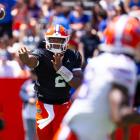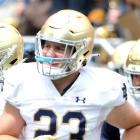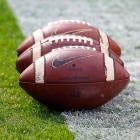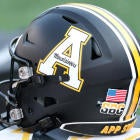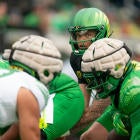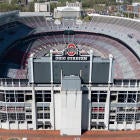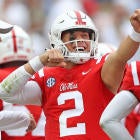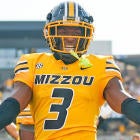College football and the NFL have a problem: too many underclassmen leave and go undrafted. Everyone knows this is a major issue, yet no one can figure out a workable solution.
The latest NFL Draft highlights what’s going wrong. Thirty-one percent of declared underclassmen didn’t get drafted, according to NFL.com, whose list didn’t count players who have already earned degrees but had NCAA eligibility remaining.
This isn’t an aberration; it’s a trend. Underclassmen went undrafted at rates of 29 percent in 2015, 38 percent in 2014 and 30 percent in 2013. Back in 2012, the rate was 18 percent.
Just six years ago, 53 players declared early for the draft -- at that time, that was considered an epidemic. Today, that number gets roughly doubled on an annual basis.
Undoubtedly, some players are getting bad advice from agents, runners and financial advisers on where they’ll be drafted. But if college football and the NFL believes the solution is to give fewer draft evaluations to underclassmen, which is what has happened in the past couple years, they’re missing the point.
Now more than ever, college football players understand they have only so many hits that their body can absorb in a lifetime. Some prominent NFL players are retiring at younger ages because of health concerns.
The NFL rookie salary scale was created to protect owners from spending lucrative contracts on unproven players. The hope was more underclassmen would return to college because of lower dollar figures. Instead, that sped up leaving early. The idea is to get to the NFL as soon as possible to start the clock toward a second contract that could be more lucrative.
Even if that second contract never comes -- and more often than not, it doesn’t -- the money that could be earned by staying typically isn’t good enough for an underclassman to delay NFL entry and try to improve his draft position. The result: Increasingly, there are underclassmen who haven’t finished school and will soon be searching for employment.
The NCAA could incentivize more players to stay by allowing them to be paid in college for use of their names, images and likenesses (think autographs, jersey sales, video games, etc.). But since the NCAA is fighting that very issue in court, don’t hold your breath on that happening anytime soon.
There is another way the NCAA could help: Let undrafted players return to college and play. If the NCAA won’t allow players to be paid even though some clearly have value beyond their scholarship, at least let them return to the football field and basketball court if they’re not drafted.
Coaches would understandably have some concerns. Teams must fill roster spots in recruiting, and coaches want to know what their roster looks like without waiting a couple months.
But in reality, virtually no college football team uses all 85 scholarships on recruited players. Also, attrition happens throughout the spring anyway due to transfers, injuries and scholarship number crunching. Some starters now don’t arrive on campus until the spring or summer as graduate transfers. What’s the difference if an undrafted player returns by a designated date?
Not every undrafted player would -- or probably should -- accept the offer to play in college again. Some would become undrafted free agents and try to make an NFL squad. Some need to enter the work force to pay bills for their families. Some would have no interest in returning to school since they left early because of poor grades and/or trouble off the field.
But some players might like the option. If the NCAA wants to keep clinging to the idea of amateurism, it could attach the stipulation that undrafted players can only return if they haven’t signed with an agent or accepted money from a third party.
The NCAA and its members say they’re about providing athletes with the best opportunity for an education and not using them as assets in a multibillion-dollar commercial enterprise. So if we’re to take them by their word, why not provide a pathway back toward college for undrafted players?
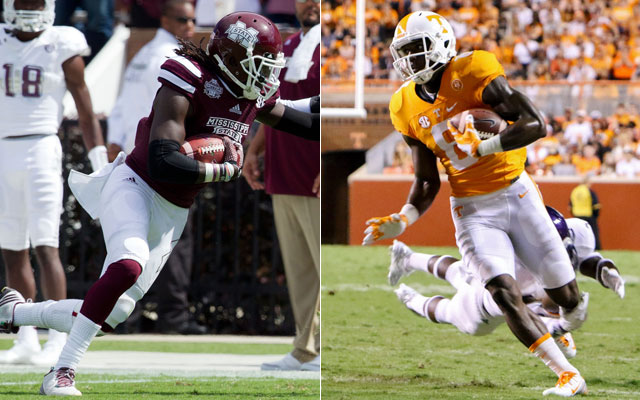
Putting aside sports for a minute, there is a growing and huge gap in college completion rates between rich and poor students in America, according to a 2015 study by the University of Pennsylvania. In 2013, 77 percent of people from families in the top income quartile received at least a bachelor’s degree by the age of 24, up from 40 percent in 1970. But only 9 percent of adults in the lowest income bracket did the same, compared to 6 percent in 1970.
We know that many athletes in football and men’s basketball come from poor backgrounds. A person is more likely to finish college at a younger age than once he or she is older, has a family and is in the workforce. Allowing players to continue playing in college if they go undrafted might motivate some to return to school and get closer to graduation.
NCAA president Mark Emmert sounded open to a concept sort of like this during a 2014 interview with me that touched on basketball players potentially returning to college.
“OK, if you go play a year in the D-League, does that mean you never, ever come back to college to play? I don’t know,” Emmert said. “Maybe that’s something we need to think about. I’m open to consider[ing] that. But again, that’s me and not the members. I’m sure coaches would have their concerns about that and I understand why. You wouldn’t want it to be a revolving door that one year I’m here, the next year I’m in the D-League. You’d have to structure it.”
Football has no such minor league system (well, other than the NCAA). College football and the NFL can’t even get their act together to create a better system for players to make informed decisions on their pro chances.
In college basketball, the NCAA now allows underclassmen to try out for NBA teams and later return to college a couple weeks before the draft. Previously, the NCAA’s deadline didn't allow players to participate in the NBA Draft Combine. Most people agree this change is good. It lets players make more informed decisions on their true status as a draft prospect.
In college football, the NFL Draft deadline for underclassmen this year was Jan. 18 for an event held in late April. That’s ridiculously early, especially since college football's national championship game gets played just a week earlier. The deadline prevents players from returning to school if they don’t like what they hear at the NFL Combine or during workouts with teams.
The NFL changed its evaluation process in 2014 to limit which players receive grades before deciding to declare early. The league used to have five categories, but now it’s three -- first round, second round or neither (which equates to advising the player to stay in school). It’s hard to see how less information helps over the long run, but that’s the approach college football and the NFL have taken.
The NCAA and Power Five have yet to find a way to allow football and men’s basketball players to have appropriate representation when considering their pro options. Once a hot topic, it’s like the issue is out of sight, out of mind.
Some major people in college sports, including then-SEC commissioner Mike Slive, started talking six years ago about letting agents have better contact with players. Then-Big 12 commissioner Dan Bebee even suggested agents could have contracts with players and schools with clauses that would cost the agent money if he did anything making the player ineligible under NCAA rules. The general idea: More sunshine would promote the agents who are more ethical.
The NCAA now allows baseball players to have agents negotiate on their behalf with professional teams (it was already happening anyway) and retain college eligibility. Yet there’s still a major difference with how the NCAA views agents for football and men’s basketball players.
“There’s no doubt we’ve got to clean that up because those principles are the same for that student and that family,” Penn State athletic director Sandy Barbour said last month at the Associated Press Sports Editors Mid-Atlantic Region meeting. “Where do I get advice? How do I know I’m making a good decision?”
If you think letting undrafted football and basketball players return to college would be chaotic, try being a college baseball coach piecing together a roster with 11.7 scholarships on moving targets with his recruits and college juniors. Major League Baseball’s draft is June 9-11. MLB gives drafted players until July 15 to sign professionally, or they return/start college.
The number of underclassmen going undrafted by the NFL can’t keep getting brushed aside. If nothing else, college football coaches are going to be up in arms even more because they keep losing productive players early who aren’t deemed good enough to get picked in a seven-round draft.
Given the brutality of football, the NFL’s salary rules and the unrealistic pro expectations that many athletes possess, there’s not a one-size-fits-all answer to the underclassmen exodus. But the impact of not getting drafted can be lessened.
“What keeps me up at night is that we all know there’s a huge number of students-athletes who have grossly unrealistic expectations of playing professional sports,” Emmert said in his State of the NCAA address in January. “There’s a lot who are going to have that dream taken away, and they are going to have to deal with reality.”
So offer a welcoming hand, NCAA. Since you're all about opportunities, let them back in if that's what they want.
Follow and read more from Jon Solomon on Facebook and Twitter.













